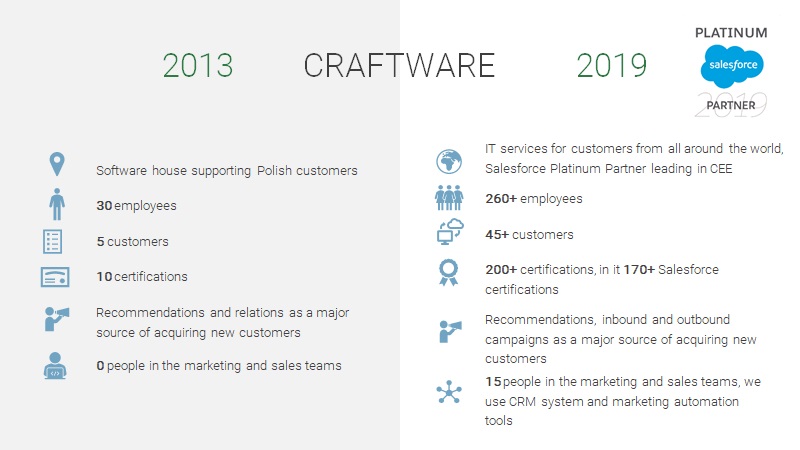Determine priorities, then decide
When in 2013, we decided about CRM implementation, our company consisted of 30 employees, mainly developers. There were no structures, no sales or marketing teams. They were not needed to support five customers.
We set ourselves an ambitious goal: our small software house income from year to year should steadily increase. And that primarily meant our team enlargement. For the marketing and sales departments – creating it from scratch.
Numerous studies and rankings (including Gartner) confirm the meaning of process automation using CRM for the development of the company. Its implementation is a key decision, both in business and technical terms. This solution is for years, so it needs to be implemented wisely and – just like us – set clear priorities and challenges. Find out how to do that.
Image – Craftware’s own elaboration
What were our priorities? Among other things, efficient communication in the enlarged team, which is something really significant in the company from the IT industry because we work in the projects, often remotely, in dispersed teams. Usually, employment is a B2B contract, and that is why tools for accounting working time or invoicing are needed. Measuring the effects of our activities – meaning reporting and dashboards – is another our priority. But most of all, the processes required to be sorted out first.
We could create them or implement ready-made solutions, so-called out of the box – cheaper and faster. Among others, Salesforce platform offered them, and we, as its partner, already knew them.
Salesforce Pardot and Salesforce Sales Cloud – because it is about them – provide with ready patterns/procedures. They are proven and scalable, and that is what we were looking for: a secure technology that will develop together with us.
So how do we work thanks to it?
1st stage of the customer journey – Salesforce Pardot
A potential customer has just visited our website: interested in the offer, submitted a form on the site, left you their contact. At this very moment, Pardot, a tool designed for marketing automation activities, tracks the potential customer and sends them a message, with the company’s offer attached.
Similarly, Pardot sends announcements about our business events: a potential participant receives an email confirmation of registration, e.g., on a webinar, and detailed information on how to join the event or unsubscribe.
Now, it is up to the potential customer’s next step, where the system will direct them. Pardot matches the path of communication to activity, so it can build involvement and provide incentives for contact. And every user’s step on the website, a click or opening e-book, translates into scoring. The maximum score means the potential customer is ready to be redirected to the sales team.
Of course, a marketing team employee has access to the potential customer journey, in real-time, from the moment of their appearance on the website.
Pardot enables communication automation and easy management of this process. The marketer is given an intuitive module for creating content and configuring marketing paths. And they consist of many activities: sending emails, adding prospects to groups, scoring, redirecting to the sales team, etc.
And what about reporting on the marketing level? Also in this area, Pardot provides tools which give you an insight into results in selected period (among other things, new prospects, business opportunities, time needed for move from one stage to another, ROI for specific campaigns).
2nd stage of the customer journey – Salesforce Sales Cloud
When the potential customer achieves the assigned score, their journey at the stage of marketing is finished. Then the potential customer is in the care of the sales team, meaning the tool Sales Cloud. Following our terminology, a prospect turns into a lead.
What does working with a lead on the sales side look like? At the beginning, a sales person gains access to the history of communication with the lead (taken from Pardot) and all of the data necessary to contact. Here, just as in the marketing stage of journey, the Salesforce Platform gives tips and tricks about the process and certain parameters, according to which it is possible to estimate the sales opportunity. Thanks to that, it is easier for the sales person to determine priorities and invest their time in the best promising leads.
What does working with a lead on the sales side look like? In the beginning, a salesperson gains access to the lead communication history (taken from Pardot) and all of the data necessary to contact. Here, just as in the marketing stage of the journey, the Salesforce Platform suggests a ready process and certain parameters, according to which it is possible to estimate a sales opportunity. Thanks to that, it is easier for the salesperson to determine priorities and invest their time in the best-promising leads.
The salesperson also can use some tips given by the system under the scheme of working with the lead. With their help, the employee of the sales team can easily create an account for the customer, but mostly, the sales opportunity, which enables monitoring progress in the process. It consists of a few steps – the needs analysis, submitting an offer, negotiations, and closing. As a result, both the salesperson and their supervisor monitor up-to-date on which stage is a particular business opportunity.
Talking about the sales opportunity in an evident way raises the question: how not to miss it? The salesperson needs not to worry about that, because they have access to the mobile app. And it gives them an insight into all of the information, also guarantees continuous contact with the customer and ongoing sales process. Therefore, even being out of the office, on the way to the meeting, the salesperson can reach out to the customer, who had just finished their journey in the marketing stage and became a new lead.
The app provides many facilities, valuable, especially when we work on the run. For example, it enables you to record your notes after a conversation with a customer.
3rd stage of the customer journey – Salesforce Spectrum
The salesperson closes the business opportunity and finalizes the sale. That is when the sales stage ends, and the project stage of work with the customer begins. Before the salesperson is the last mission: to send a signal to the project management team with the information about the new assignment.
At this point, the customer and their project end up in Spectrum. This tool, in contrast to those described above, is our original solution, considering in detail the specificity of project working. We created an app at the Salesforce platform to manage customer projects and internal processes. As a result, Spectrum supports the HR work, and also, it is the tool to account for the working time.
What information does a project manager receive? Along with the history of the entire journey that the customer has gone through the system, the project manager gets a draft of the project that can be defined, and then tracked for profitability. Taking into account the time spent on the project by team members who log in to the system, the module calculates revenue, real cost, and profit from the project.
The tool also gives the ability to monitor work progress in different projects, employee occupancy, and to control if the supporting the project is not needed.
A person who manages the project receives all of the information on dashboards tailored to the needs of his position. These kinds of reports are also useful for a sales director who is interested not only in individual customers but in wider insight into the company’s situation.
Summary
What did the implementation of Salesforce at Craftware give us? The team got the tool that makes every work stage easier, and the benefits of automation are seen daily. First and foremost, it is full access to the information, continuous contact with the customer, smooth customer transfer from one department to another, and the ability to monitor project work.
Looking at the results of the CRM implementation in the bigger picture, we might say that we fulfilled all the goals we set six years ago. Our income is constantly increasing. These outcomes are comparative to the global KPIs given by the Salesforce, achieved by organizations thanks to the process automation (primarily, increase in revenue, ROI increase from the marketing campaigns, and the speed of the implementation).
Image – Craftware’s own elaboration
Our example shows that rapid development is possible without risking excessive development of the back office or early stopping of business growth. What is most important, we did not waste time creating solutions and reinventing the wheel. Usually, it pays off to use something that had been already invented.
So what are we planning to do next? Ahead of us, there is a better sales forecasting, meaning an income from the projects. We intend to develop functionality associated with specialists allocation and evaluating their potential. It will help in assigning specific employees according to the projects.
Our team is still growing, and we already feel the need to expand the Spectrum module with new company processes, such as delegation service. We also want to add more dashboards that allow you to familiarize yourself with key data in a clear and transparent form.
- Expert in the Marketing Team
-
She has always been associated with the written word – as a journalist and editor in press publications. A copywriter in the new technologies industry for several years. When she does not write, she loves to talk and meet people. In love with electronic music.



